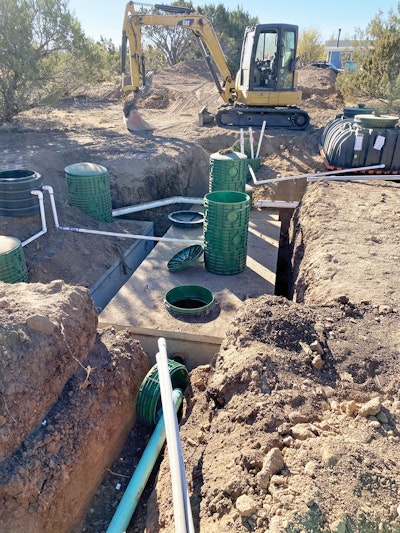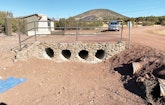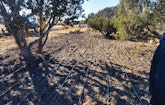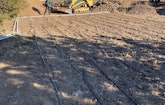
Shown on the work site are, from left, installer Mike Palmer, owner and developer Jeff Fox and system designer Ian Braun.
Interested in Systems/ATUs?
Get Systems/ATUs articles, news and videos right in your inbox! Sign up now.
Systems/ATUs + Get AlertsAbout 50 miles south of the Grand Canyon, just north of Williams, Arizona, is a sprouting collection of cabins to serve this tourist area. Inn History is a group of new cabins that needed a new wastewater system, something capable of using the tough clay soils of this country. Cabins have one bedroom, sleeping space for four people, a bathroom, kitchen and other amenities such as a refrigerator, air conditioning and Wi-Fi.
It is only the first phase of the cabin complex has been built, but there is a wastewater system in place to serve what’s on the ground, and plans are set for the second phase of the development.
Solution
Wastewater from the first six cabins in the project, and from an office building, is collected in 4-inch schedule 40 PVC pipe. First in the treatment train is a 1,500-gallon concrete tank for settling and anaerobic treatment. That tank, like others for the project, came from Yavapai Precast in Prescott, Arizona, says Ian Braun of Civil Design & Engineering in Flagstaff, Arizona, who designed the system.
From that tank, wastewater flows about 2 feet into a 1,000-gallon concrete recirculation tank. Inside are duplex Little Giant 20 gpm high-head effluent pumps. Pumps send wastewater into an 800 gpd Anua AeroCell pod housed in an Infiltrator Water Systems tank. From the pod, 80% of wastewater returns to the recirculation tank while 20% flows about 6 feet to a SALCOR 3G UV system. UV was required because of the proximity of seasonal high water, Braun says.
Water next enters a 1,500-gallon concrete dosing tank. Because this tank has capacity to store a day’s worth of wastewater, there is only a single pump inside, a Little Giant 20X high-head effluent pump. It sends water about 40 feet to the headworks box for the Geoflow absorption field with 1,352 feet of drip tubing.
Because of the long pipe runs needed to power the system by gravity, some of the tanks had to be set deep. Cover was 36 inches maximum.
The property covers 1.65 acres, and the owner has plans for nine more cabins that will use a second treatment system with the same basic components but more capacity. The pretreatment tank, for example, will be a 2,000-gallon model, the AeroCell unit will have a capacity of 1,500 gpd, and the Geoflow field will have 1,872 linear feet of tubing.
Yavapai Precast also supplied risers and lids.
Usual soils
One of his challenges on the site was the clay soil, but it’s not an uncommon challenge.
“Williams, Flagstaff, northern Arizona, this is typical: very challenging soil conditions, shallow rock and silty clays and clays,” Braun says. “They just don’t drain. They hold water, and they hold seasonal saturation.”
All test wells must be inspected by the county, and it’s common for them to discover signs of high seasonal water, which has a minimum separation of 6 inches from any drainfield, he says. High water typically means chlorination, but in this case the choice was for UV to provide an extra margin of safety, he says. Obviously bulbs need replacement, he says, but given the high flow, UV is also more convenient than frequently replacing chlorine tablets.
Water from the absorption field irrigates the natural vegetation. There is no municipal water service to this property. Freshwater is hauled in, Braun says. Groundwater saturation is seasonal and the aquifer is perched, meaning there are small pools of water in the soil but above the actual aquifer, which is down a couple of thousand feet. “So any way you can reuse water is greatly beneficial and a huge cost savings.”
Before the site plan was done, engineers bored test holes all over the property to determine the best spot for wastewater disposal. But soils were consistently bad, Braun says. “We were driven by maximizing the number of cabin sites while still being able to fit disposal.
“I did the preliminary site planning just because so much of it was driven by where and how much wastewater disposal we could put on the site,” he says. It was a change from the typical order of projects, he says, where buildings are sited first and wastewater planning comes later.
Factors in choosing the system
Under state and county rules there were dozens of pretreatment options, Braun says. His design was driven by two factors. First, he needed a system that treats to a very high degree, which would allow him to adjust the soil absorption rate and fit the disposal field on the site. Second, the contractor installing the system had limited onsite experience (and was doing other site work for the cabins), and Braun knew Anua would provide good technical support.
“With Anua’s support during the install, everything went very smoothly,” Braun says.
During installation, tanks and the absorption field had to move a few feet to preserve some trees on the property. Most of the trees are junipers.
“And it’s a nice thing to save on a site like this,” Braun says. “You have to understand these are little cabins. Everyone staying in the cabins pretty much is coming to visit the Grand Canyon so they want a real Arizona experience.”
Another reason for picking the Anua system was a strong concern from the owner to limit odors. “And I have never had any kinds of issues with Anua in that regard,” he says.










